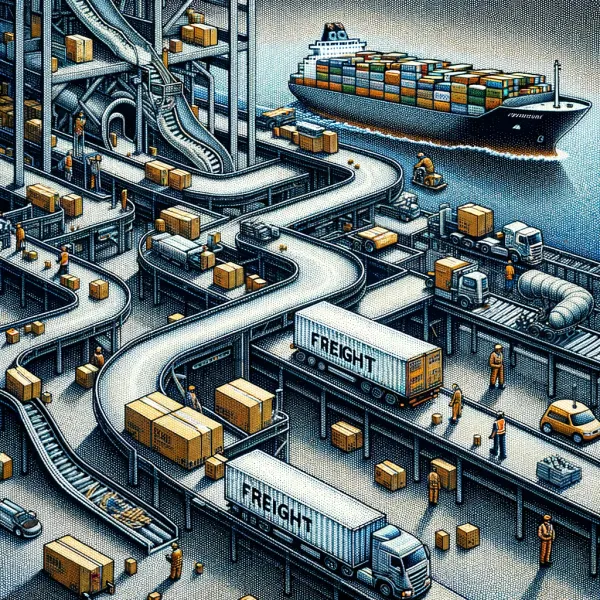
Five Supply Chain Predictions for 2023
Written by Jon Bradford and Santosh Sankar, 2023-01-18
Summary
- We see 5 trends that will prove interesting into 2023. Topics range from robotics, sustainability, through to embedded payments, credit, and insurance
- Listen to the accompanying podcast. More here for your audiophiles.
- Email us! We want to hear from you if you’re a founder - email us at [email protected] to chat
We sat down at the end of last year and asked ourselves questions such as: “What is interesting going into 2023? What does that mean for us as seed investors?” We ultimately shared this with our LPs and now with the broader public.
But first, a quick context note: we don't believe that most things in the world are worth predicting. Discussing things like the economy, venture capital, and even the supply chain are challenging because they’re complex systems that have hundreds, thousands, if not millions of variables that we cannot necessarily identify. Rather, we look at secular trends and focus on what opportunities might profit us. This approach seems a bit more informed and constructive as it also affords the opportunity for bottoms-up analysis of each opportunity area as it’s identified.
Labor Scarcity Continues to Advance Automation
Labor scarcity is something that’s been plaguing multiple industries across the globe like healthcare, education, and - of course - supply chain.
According to American Trucking Associations (ATA), the industry is still facing its second-largest number of driver vacancies on record, even after >90% of carriers raised pay last year. Elsewhere, according to the US Bureau of Labor Statistics, there’s 1.27M open manufacturing and warehousing jobs positions with only 759K new hires as of last November. We can continue spitting off facts if that will help get our point across but the fact of the matter is that this labor issue isn’t going away anytime soon. Putting the reason for the shortage aside, all these stats point to the fact that labor scarcity has been top of mind across the supply chain, whether you're in manufacturing, ports, trucking, warehousing, or last mile delivery. We believe it’s driven by a few factors:
- This is really a global statement in developed markets, but there's less of an interest or desire to do the dirty, dull, and dangerous work.
- In the US specifically, we have birth rates that have dramatically fallen off. In the early 1950s, there were 24 births/1K people in the United States. By 2019, that number dramatically fell by more than half.
- Today’s political environment has not necessarily been as welcoming to the populations that have occupied these frontline positions in a bid to give themselves and their families a better life.
This year in particular our minds are on environments that are conducive to automation or in other words, constrained. There are fewer “unknown knowns” which is where you can automate physical workflows in a manner that makes commercial sense. Consider airports for a second. A few of us on the Dynamo team travelled to London in November of 2022. We were worried about our checked bags because the labor group in charge of handling the luggage threatened to go on strike. We believe this environment could be conducive to automation - as it’s a repeatable process with rather homogenous items. Does it make sense to have parts, if not all of this process over time, automated away? These environments will definitely gain more interest or more attention than perhaps years prior.
Digitization Drives Better Margins and Service
As we think about automation in the wake of labor scarcity, another interesting trend that has already begun shaping supply chains over the last few years is digitization and related workflow automation. And yes, digitization can feel overused but it’s something that will continue to come up in conversation.
This year specifically, we see the narrative shifting away from “scaling growth” to “improving margin” as we head into a more obviously weak macro environment. We’ve observed in sales conversations that the pitch is less about more efficient scale and handling of growth volume but rather about cost reduction and margin preservation. Deloitte released a report that found that software automation can reduce costs by about 30% (that's wild!). This is especially mind-blowing when we consider that environments such as brokerage, forwarding, warehousing, etc remain under-penetrated relative to other sectors. We suspect that a 30% figure could actually be higher in supply chain.
Digitization also answers the industry call for greater visibility and transparency. While these two terms can also be considered buzz words, they both remain largely unsolved. As we look across the five areas of supply chain that we defined, there is yet to be an established category leader in most areas. Take warehousing which is still considered to be a black hole when we talk to supply chain managers. Additionally, we see verticals as an interesting opportunity area and some examples in our funds include companies like Milk Moovement and Skupos. We’ve spent time considering opportunities in air freight where utilization in the belly of aircraft is generally poor. Is there a model where someone can offer a full stack solution in a clever way? We’ve also looked at “picks and shovels” by selling software to industries such as construction. The list goes on.
Economic Weakness Won’t Stun Sustainability
Increasingly, companies are setting sustainability goals as customers, suppliers, and regulators demand it. This generally maps to reduce reliance on carbon-intensive practices in transportation and manufacturing. We note that some of these goals might come across as lofty, such as in General Motors’ case, but they really signal the awareness and urgency required to be good stewards of the planet.
We firstly draw your attention to the Inflation Reduction Act in 2022 (or IRA). This piece of legislation has effectively cornerstoned the push to reduce US GHG emissions by 32% to 40% by 2030 compared to 2005 levels. We do note that there are certain parts of this legislation that need to be more clearly defined in terms of government support.
We’d be remiss not to call attention to the application and implementation of electrification. Obviously it’s a major step in the right direction and one we believe makes sense for last mile and consumer transportation. That said, we don't believe electrification makes sense in certain applications where distance and payload are critical factors. We see hydrogen playing a major role in areas such as long haul trucking, air transport, and decarbonization of manufacturing. The IRA has accelerated the timeline for hydrogen from what most people thought was around 2030 to today. In conjunction, private market investors are taking this time to double down on what they believe is investable and interesting - money isn’t going away.
Sovereignty Drives Regionalization Of Supply Chains
We couldn’t speak about 2023 without mentioning the broader push for nearshoring as it’s been covered by a number of outlets and firms (check out our piece on nearshoring: 🏭A Deep Dive Into Regionalization And The Implications It Has On VC).
Just as the name of this sections states, we see sovereignty, national security, and societal welfare leading the charge for reshoring of crucial industries such as semiconductors, pharmaceuticals, healthcare consumables/supplies, and high-tech materials. One will notice that there’s a relative price inelasticity or sensitivity to these goods for each of these industries. If semiconductors go up in price, we're still going to ensure that we have a laptop to do work and a car to travel in (we saw this during COVID!). It’s the same for pharmaceuticals, healthcare supplies, and materials that are used in defense applications. Of course, we’ll have to figure out and shoulder the inflationary undertone to this trend. Ultimately, when we don't have these materials, bad things happen.
Aside from sovereignty, there are other factors companies are considering such as tax breaks or access to skilled labor pools. We do note that in order to receive import tax breaks, companies have to abide by the United States-Mexico-Canada Agreement (USMCA). This legislation states that organizations need to have local resources, whether that's the actual raw materials, the manufacturing, or the actual value add by labor, while demonstrating that the product’s components are largely sourced from either the US, Canada, or Mexico. We note that the IRA reinforces this as it tries to jump start the US battery supply chain. Supply chain managers also are focusing on “the total equation” as rising transportation and labor costs are disproving some of the key parts of globalization. In some cases, it might actually be more inexpensive to have your suppliers, manufacturing, and assembly closer to home when you factor in both hard costs as well as the cost of risk and interruption.
Payments, Credit, and Insurance Are Emerging
Last but certainly not least, is the increased intersection between finance and supply chain. Our FinTech friends call this “Embedded FinTech” but we think of payments and freight movement as different sides of the same token. Oftentimes the same visibility data points that you need to move freight as a supply chain manager, is what’s required to remit payment, release trade credit, or better underwrite insurance. We see this as an interesting way to perhaps dislodge existing incumbent business models, but also a way to think about, “How can one can actually re-engineer this entire competency?”
If we were to go back to the Renaissance era, one would see that traders such as Marco Polo provided both supply chain and financial offerings side by side. If we venture further back in time, the Mesopotamians used basic forms of invoice discounting for financing trade. As we tend to say, history rhymes if it doesn’t repeat.
We have a couple of our portfolio companies demonstrating this trend- Solvento, LogRock, RedSky and the Raft AI team out in the UK.

Want to learn more and dive deeper into the key trends for supply chain in 2023? Then check out one of our latest podcasts, 🎧#147: Santosh Sankar & Clay Katzman of Dynamo Ventures. Want to have a chat about upcoming trends? Ping us an email at [email protected] so we can talk shop.
Check out one of our other posts.


